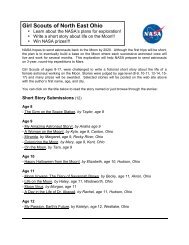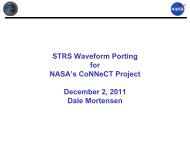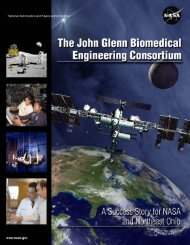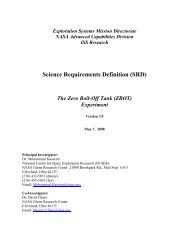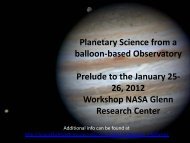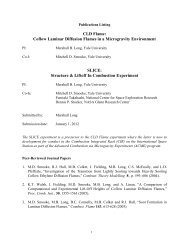Amusement Park Physics With a NASA Twist - Space Flight Systems ...
Amusement Park Physics With a NASA Twist - Space Flight Systems ...
Amusement Park Physics With a NASA Twist - Space Flight Systems ...
You also want an ePaper? Increase the reach of your titles
YUMPU automatically turns print PDFs into web optimized ePapers that Google loves.
Names<br />
Collisions—Part 1—Answer Key<br />
Task<br />
You will be observing colliding marbles, which demonstrate the<br />
conservation of momentum. The momentum of a moving object<br />
is the product of its mass and its velocity (M = mv). If all of the<br />
marbles are identical in mass and size, a moving marble will<br />
transfer its momentum to a stationary marble when they collide.<br />
Date<br />
Materials<br />
• Plastic ruler with center groove<br />
(30 centimeters long) or similar<br />
items for tracking the marbles, such<br />
as grooved wooden molding<br />
• Eight identical marbles<br />
Parameter<br />
Make sure your marbles are identical in size and mass.<br />
0<br />
1<br />
2 3 4 5 6 7 8 9 10 11 12<br />
cm 0 1 2 3 4 5 6 7 8 9 10 11 12 13 14 15 16 17 18 19 20 21 22 23 24 25 26 27 28 29 30<br />
Don't forget to return the<br />
marbles.<br />
Procedure<br />
1. Place all eight marbles in the ruler groove next to and<br />
touching each other.<br />
2. Pull one of the marbles about 10 centimeters away from the<br />
rest and then push it back toward the other marbles, giving it<br />
some speed. Note what happens when the marbles collide.<br />
3. Place the marbles back at their original position and pull two marbles about 10 centimeters<br />
away from the rest. Push the two marbles together toward the other six marbles so that they<br />
collide. Note what happens after the collision.<br />
4. Repeat step 3 with three marbles, then four marbles, and finally, five marbles.<br />
Conclusion<br />
1. When one marble bumps against the other seven, why does just one marble move away<br />
Momentum is conserved in elastic (frictionless) collisions. One marble impacts the other with a mass times velocity<br />
causing another marble of the same mass to move away with the same speed as the impact speed (disregarding friction).<br />
2. Did the other six marbles move much after the first collision Why No, they did not.<br />
Momentum was transferred from the first marble through the line of marbles to the last marble.<br />
3. How many marbles moved away when you pulled three marbles back and made them collide<br />
with the remaining five marbles Three marbles moved away and two marbles remained stationary.<br />
4. If you were to use a twice-as-massive marble to collide with the seven other marbles of regular<br />
mass, would that cause just one marble to move away Explain. No, in order for momentum to be<br />
conserved, the mass times velocity of the initial marble equals the mass times velocity of the marbles that move off. The more<br />
massive marble would cause two (or more, depending on how massive the marble is) smaller marbles to move off slowly.<br />
5. Would the end marble also move faster when one is hitting the row with a faster speed Yes,<br />
the mass times velocity of the initial marble equals the mass times velocity of the marbles that move off. The faster the velocity<br />
of the incident marble, the faster the end marble will fall off if the masses are equal.<br />
102<br />
<strong>Amusement</strong> <strong>Park</strong> <strong>Physics</strong> <strong>With</strong> a <strong>NASA</strong> <strong>Twist</strong><br />
EG–2003–03–010–GRC



